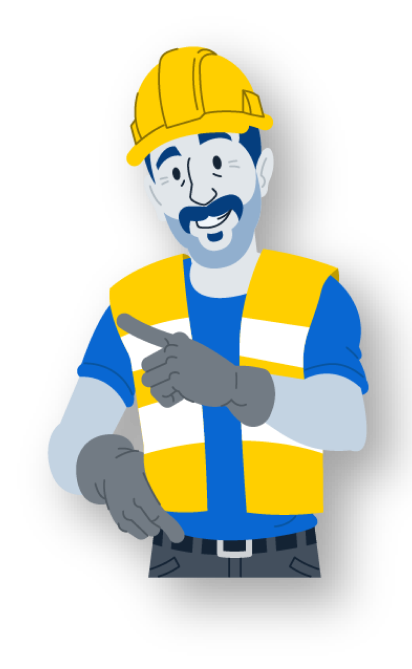Have you ever had a conversation that left you feeling accomplished? Or with great sense of satisfaction? Or conversely, left you red in the face due to embarrassment, frustration, or anger?
Let’s face it, talking to people can be tough.
Whether you’re struggling to communicate your point or feel misunderstood due to language barrier, miscommunication comes in all forms.
But what if you, as a landscaping contractor, mastered the art of communication? What if all conversations left you feeling accomplished and satisfied? Would working with colleagues and managers, clients and subcontractors be more enjoyable and productive? Would time and money be saved while a sense of teamwork and collaboration was elevated?
Well, if you’ve found yourself red in the face on more than one occasion, we’re here to help!
Follow along below to learn how communication between your company and crews can be improved (and say “BYE” to those red faced moments for good)!
Communication in the Works
When the word “communicate” comes to mind, most people will think of speaking and writing. However, a majority of communication comes in a different form: nonverbal communication. What do these ways of communicating look like?
Verbal Communication
Verbal communication is pretty straightforward, it’s what you say and how you say it. When talking with someone, whether that be a coworker, employee, or client, the words you string together create meaning that you’re hoping the other person will understand.
To try and get our points across even further, the tone we use and the emphasis we place on certain words can change the meaning we want to convey (i.e. YOU did a great job! vs You did a GREAT job! — here, you’re either praising the person or praising the work).
Nonverbal Communication
Nonverbal communication isn’t what you say, it’s what you don’t say that adds emphasis to your message. Examples of nonverbal communication can be written messages or body language. With written communication — unless very straightforward — there’s a lack of tone. The intention of the message can be lost (people using emojis 😅👀🤦🏼♀️🤔 and phrases like “lol” or “haha” to give a better sense of tone).
Body language is the biggest form of nonverbal communication, clocking in as the first type of communication a new person picks up on before words are even exchanged.
Look like you’re having a bad day? Is there a huge smile plastered on your face? Are your arms crossed or shoulders relaxed? All of these physical “tells” people your unspoken impression about a conversation before it even starts.
Fremont University shares more about the secrets behind common nonverbal cues. Your eyes, facial expression, and hand signals give away a lot more than you think!
Issues that Arise
Whether it be verbal or non-verbal communication, there’s always the risk that an issue will come up.
Verbal Communication issues may show their ugly heads for a few key reasons:
- Is it straightforward? When trying to get information across, simplicity is key. What are you asking your crew to do? Have expectations for production been clearly detailed? By ensuring your message is to the point with enough detail to guide your team, you eliminate room for potential misunderstandings.
- Is it understandable? It may seem obvious, but is your message understandable by the person/group you’re speaking with? Are the terms and phrases being used recognized by the other party? Is there a language barrier that could break down comprehension? It doesn’t really matter if you know what you’re saying or not if your message isn’t understood by the other person/group. At that point, communication has broken down and misunderstandings are bound to happen.
- Does the tone match the message? When speaking to a client or a colleague, does your tone match the message you’re trying to share? We’re all human and subject to emotions. Maybe you had a rough day, something is happening in your personal life that’s being carried over to your work life. Whatever it may be, if your tone is at odds with your message, the understanding you want to get across may not make it to its target.
How to Bridge the Communication Gaps
When we strive for transparent communication among crew members, office staff, clients, collaborators, and other 3rd parties, looking for ways to bridge existing communication gaps is essential. If you’re not sure where to start, take a look below for some tips on helping eliminate miscommunications once and for all.
Verbal
Voice Memos/Videos: Having a voice memo or video that goes along with your message can be a major help, especially if a language barrier is present. It gives the other party an opportunity to re-listen to what you’re trying to get across. They can hear tone, read body language, and (depending on your platform) use subtitles to add a second layer to help better understand.
Get feedback from others (or yourself!): Have a friend, family member, or colleague listen to how you deliver information or record yourself and review. Having a second set of eyes — even if they’re your own — will give you a second opinion on what may be causing the misunderstanding. Is it the delivery? Intonation? Does the other party simply not care? Or is something else going on?
In my first ever Nicole’s Notes, I used video as a way to communicate landscaping tips. And I definitely got feedback on my communication before putting it live on YouTube! Leave a comment on the YT video of communication elements
Nonverbal
Photo Documentation/Annotation: When on a job site, ensuring quality work is done in a timely and effective manner is important to the success of your business. Using photo documentation and photo annotations to point out important information can be the difference between a job disaster and a job well done.
Written Communication: If what you’re putting down isn’t being picked up by the other party, written communication can help. It provides the opportunity to translate into a first language if a language barrier is present, and can also serve as a record of what information is important so others at the job site can see what’s needed and help explain further if you’re not present.
- To-Do Lists: If you’re like me, you may get a little “wordy” sometimes. A punch list or a “to-do list” will help with that. Your crews will know exactly what they need to do while removing the emotion from the situation. Everything is purely factual (i.e. do this, not that, check this, save that) without compromising the SOPs your crews need to follow in order to get the job done while keeping high quality standards.
CompanyCam offers customizable to-do lists. For more information, read about how you can onboard new employees with the CompanyCam to-do list!
At the end of the day, we all want to enjoy what we do and have a sense of pride in our workmanship. Misunderstandings can be a major downer to both of those goals. If you’re experiencing mishaps on the job site or in the office due to misunderstandings, know that things don’t need to continue on in this way.
Narrow down what communication channels are being used and abused, have a candid conversation with your team member, crew, or company about the miscommunications, and have a plan in place to work through these misunderstandings. You’ll come out on the other side a better and stronger team than before!





